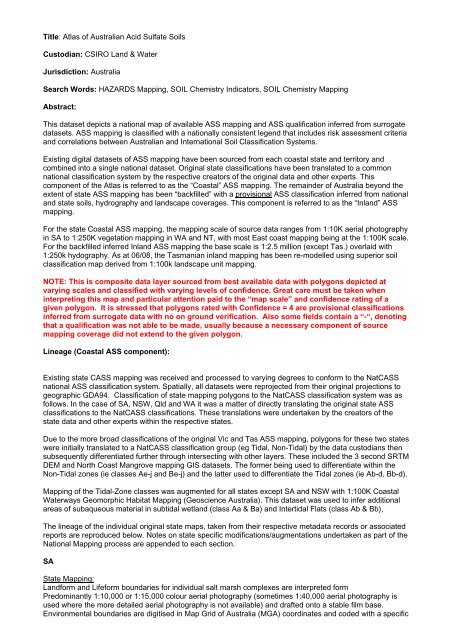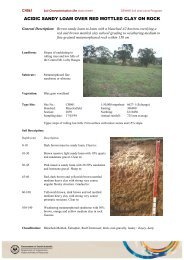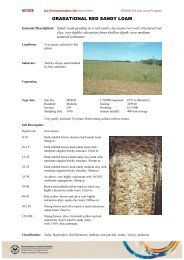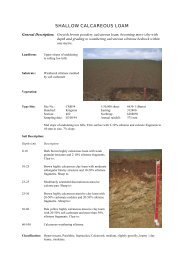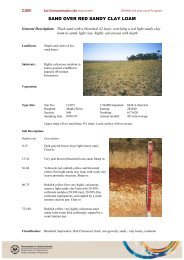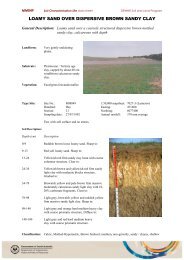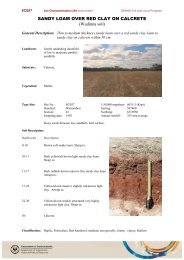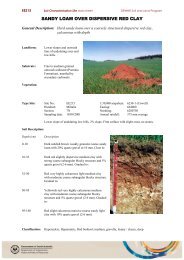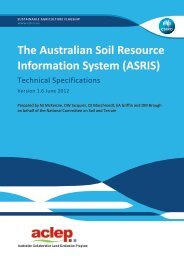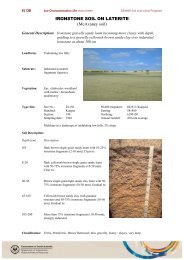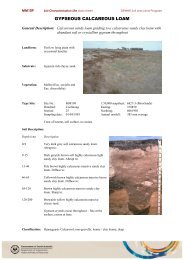Title: Atlas of Australian Acid Sulfate Soils Custodian: CSIRO ... - asris
Title: Atlas of Australian Acid Sulfate Soils Custodian: CSIRO ... - asris
Title: Atlas of Australian Acid Sulfate Soils Custodian: CSIRO ... - asris
Create successful ePaper yourself
Turn your PDF publications into a flip-book with our unique Google optimized e-Paper software.
<strong>Title</strong>: <strong>Atlas</strong> <strong>of</strong> <strong>Australian</strong> <strong>Acid</strong> <strong>Sulfate</strong> <strong>Soils</strong><br />
<strong>Custodian</strong>: <strong>CSIRO</strong> Land & Water<br />
Jurisdiction: Australia<br />
Search Words: HAZARDS Mapping, SOIL Chemistry Indicators, SOIL Chemistry Mapping<br />
Abstract:<br />
This dataset depicts a national map <strong>of</strong> available ASS mapping and ASS qualification inferred from surrogate<br />
datasets. ASS mapping is classified with a nationally consistent legend that includes risk assessment criteria<br />
and correlations between <strong>Australian</strong> and International Soil Classification Systems.<br />
Existing digital datasets <strong>of</strong> ASS mapping have been sourced from each coastal state and territory and<br />
combined into a single national dataset. Original state classifications have been translated to a common<br />
national classification system by the respective creators <strong>of</strong> the original data and other experts. This<br />
component <strong>of</strong> the <strong>Atlas</strong> is referred to as the “Coastal” ASS mapping. The remainder <strong>of</strong> Australia beyond the<br />
extent <strong>of</strong> state ASS mapping has been “backfilled” with a provisional ASS classification inferred from national<br />
and state soils, hydrography and landscape coverages. This component is referred to as the “Inland” ASS<br />
mapping.<br />
For the state Coastal ASS mapping, the mapping scale <strong>of</strong> source data ranges from 1:10K aerial photography<br />
in SA to 1:250K vegetation mapping in WA and NT, with most East coast mapping being at the 1:100K scale.<br />
For the backfilled inferred Inland ASS mapping the base scale is 1:2.5 million (except Tas.) overlaid with<br />
1:250k hydography. As at 06/08, the Tasmanian inland mapping has been re-modelled using superior soil<br />
classification map derived from 1:100k landscape unit mapping.<br />
NOTE: This is composite data layer sourced from best available data with polygons depicted at<br />
varying scales and classified with varying levels <strong>of</strong> confidence. Great care must be taken when<br />
interpreting this map and particular attention paid to the “map scale” and confidence rating <strong>of</strong> a<br />
given polygon. It is stressed that polygons rated with Confidence = 4 are provisional classifications<br />
inferred from surrogate data with no on ground verification. Also some fields contain a “-“, denoting<br />
that a qualification was not able to be made, usually because a necessary component <strong>of</strong> source<br />
mapping coverage did not extend to the given polygon.<br />
Lineage (Coastal ASS component):<br />
Existing state CASS mapping was received and processed to varying degrees to conform to the NatCASS<br />
national ASS classification system. Spatially, all datasets were reprojected from their original projections to<br />
geographic GDA94. Classification <strong>of</strong> state mapping polygons to the NatCASS classification system was as<br />
follows. In the case <strong>of</strong> SA, NSW, Qld and WA it was a matter <strong>of</strong> directly translating the original state ASS<br />
classifications to the NatCASS classifications. These translations were undertaken by the creators <strong>of</strong> the<br />
state data and other experts within the respective states.<br />
Due to the more broad classifications <strong>of</strong> the original Vic and Tas ASS mapping, polygons for these two states<br />
were initially translated to a NatCASS classification group (eg Tidal, Non-Tidal) by the data custodians then<br />
subsequently differentiated further through intersecting with other layers. These included the 3 second SRTM<br />
DEM and North Coast Mangrove mapping GIS datasets. The former being used to differentiate within the<br />
Non-Tidal zones (ie classes Ae-j and Be-j) and the latter used to differentiate the Tidal zones (ie Ab-d, Bb-d).<br />
Mapping <strong>of</strong> the Tidal-Zone classes was augmented for all states except SA and NSW with 1:100K Coastal<br />
Waterways Geomorphic Habitat Mapping (Geoscience Australia). This dataset was used to infer additional<br />
areas <strong>of</strong> subaqueous material in subtidal wetland (class Aa & Ba) and Intertidal Flats (class Ab & Bb),<br />
The lineage <strong>of</strong> the individual original state maps, taken from their respective metadata records or associated<br />
reports are reproduced below. Notes on state specific modifications/augmentations undertaken as part <strong>of</strong> the<br />
National Mapping process are appended to each section.<br />
SA<br />
State Mapping:<br />
Landform and Lifeform boundaries for individual salt marsh complexes are interpreted form<br />
Predominantly 1:10,000 or 1:15,000 colour aerial photography (sometimes 1:40,000 aerial photography is<br />
used where the more detailed aerial photography is not available) and drafted onto a stable film base.<br />
Environmental boundaries are digitised in Map Grid <strong>of</strong> Australia (MGA) coordinates and coded with a specific
landform / lifeform code. Individual salt marsh complex data sets are then re-projected into a Lambert<br />
Conformal Conic coordinate system and appended into a state-wide data set. <strong>Acid</strong> <strong>Sulfate</strong> Soil codes were<br />
determined by <strong>CSIRO</strong> Land and Water based on field soil sampling.<br />
Modifications for National Mapping:<br />
State ASS codes for polygons were translated to the National codes by Rob Fitzpatrick <strong>CSIRO</strong> Land &<br />
Water. Polygons dissolved on new National codes.<br />
NSW<br />
State Mapping:<br />
The maps predict the distribution <strong>of</strong> <strong>Acid</strong> <strong>Sulfate</strong> <strong>Soils</strong> (ASS) based on an assessment <strong>of</strong> the geomorphic<br />
environment. This assessment has involved mapping <strong>of</strong> the environments in which they are likely to be<br />
found, being the coastal lowlands up to approximately 10m AHD and carrying out fieldwork to establish field<br />
relationships between landform, elevation and occurrence <strong>of</strong> ASS. Landform elements were used as the<br />
basic mapping unit. These provide a basis for land use planning and allow the application <strong>of</strong> elevation<br />
classes so that the depth <strong>of</strong> occurrence <strong>of</strong> ASS within a landform element can be estimated. It allows the<br />
prediction <strong>of</strong> soil management problems in other areas with similar landform and soil characteristics. ASS<br />
maps are not intended to provide site specific ASS information. The information derived from the maps<br />
cannot be used in the assessment <strong>of</strong> the potential to effectively manage ASS in a particular development.<br />
When using ASS maps, it must always be remembered that that there can be expected to be extreme<br />
variations in the nature and distribution <strong>of</strong> <strong>of</strong> ASS and that the depth to the ASS layer can be highly variable.<br />
The depths given in the map key should be used as a guide only and not used for a specific assessment <strong>of</strong><br />
development potential. It is recommended that all land use activities likely to disturb ASS require appropriate<br />
soil investigations and a management plan to avoid environmental degradation.<br />
Modifications for National Mapping:<br />
State ASS codes for polygons were translated to the National codes by experts in NSW DIPNR (see<br />
acknowledgements), Polygons were then dissolved on new National (NatCASS) codes.<br />
Qld<br />
State Mapping:<br />
ASS for Southeast Qld was interpreted from 1:100K topographic maps with ground truthing<br />
Ground truthing has been carried out at an intensity <strong>of</strong> one site per square kilometre. Potential acidity has<br />
been assessed by laboratory testing and actual acidity is indicated when field pH is < 4.0. Potential acidity<br />
from soil sulfides has been assessed principally by the Total Oxidisable Sulfur (TOS) method (Method 20). A<br />
selection <strong>of</strong> samples has been tested using the POCAS method (Method 21 - Ahern et al 1998).<br />
Limited or no field checking has been carried out on disturbed lands. The outer boundary <strong>of</strong> estuarine ASS is<br />
established using limited field checking together with use <strong>of</strong> contour lines and geological map boundaries.<br />
The NS2 unit is not ground truthed at 1:100 000 scale and it should be noted that certain lithologies within it<br />
may contain sulfidic material <strong>of</strong> non estuarine/holocene origin.<br />
Base Map: Infrastructure, hydrographic and relief data supplied courtesy <strong>of</strong> AUSLIG.<br />
ASS classes for the remainder <strong>of</strong> the Qld coast were interpreted from 1:100K mangrove mapping. Landsat<br />
TM imagery was digitally classified and interpreted with colour 1:50 000 aerial photography and ground<br />
truthing.<br />
Modifications for National Mapping:<br />
State ASS codes from the SE QLD ASS mapping dataset and Mangrove polygons were translated to the<br />
National codes by experts in QNRM (see acknowledgements). Coverage was augmented with the Coastal<br />
Waterways Geomorphic Habitat Mapping for Qld dataset that had also been translated to National codes<br />
(see end <strong>of</strong> section). Polygons were then dissolved on new National codes.<br />
Vic<br />
State Mapping:<br />
Assessment <strong>of</strong> geological records, analysis <strong>of</strong> digital elevation models, aerial photo interpretation, extensive<br />
field work and laboratory analyses <strong>of</strong> soil samples were used to produce acid sulfate soil risk maps. A set <strong>of</strong><br />
1:100 000 scale maps <strong>of</strong> coastal acid sulfate soils is presented for the purposes <strong>of</strong> land management and<br />
environmental planning in landscapes in coastal Victoria.<br />
Modifications for National Mapping:<br />
Polygons in the Vic ASS mapping were assigned a NatCASS code by expertis in Vic DPI on a 1:100K<br />
mapsheet basis. The SRTM DEM was used to further differentiate the Vic ASS polygons coded to the height<br />
dependent NatCASS codes in Non-tidal zones (e-j). THe DEM was also used to differentiate Tidal zone
classes (b & c) in the cases where the Vic translations have not been specific (ie Geelong, Western Port &<br />
Warragul mapsheets). t). Coverage was augmented with the Coastal Waterways Geomorphic Habitat<br />
Mapping for Vic dataset that had also been translated o National codes (see end <strong>of</strong> section). Polygons then<br />
dissolved on new National codes.<br />
NT<br />
State Mapping:<br />
No State (Territory) mapping utilized for NT. Coastal ASS component was derived entirely from Coastal<br />
Waters Geomorphic Habitat Mapping<br />
WA<br />
State Mapping:<br />
Swan Coastal Plain<br />
Classification <strong>of</strong> map units in 1:50 000 Urban Geology (UG) and Environmental<br />
Geology (EG) map series (Department <strong>of</strong> Mineral and Petroleum Resources) conducted by Department for<br />
Planning and Infrastructure (2003) under advice from Department <strong>of</strong> Environment. Classification <strong>of</strong> existing<br />
environmental and urban geology map units updated with information from on-ground mapping program.<br />
Mapping <strong>of</strong> ASS risk around Peel-Harvey Inlet was conducted using a combination geology, soil land-scape<br />
mapping and surface contour information guided by on-ground soil survey information and aerial<br />
photography. Soil-landscape mapping used for this process consisted <strong>of</strong> Department <strong>of</strong> Agriculture 1:50 000<br />
soil-landscape map sheets Peel Harvey north, Mandurah-Murray, Peel-Harvey South and Harvey-Capel.<br />
NorthWest WA<br />
Classification <strong>of</strong> 1:100 000 NW coastal wetland map units (obtained from the WA EPA from work undertaken<br />
for the NorthWest Shelf Coastal Wetland Mapping, 1999-2000) was undertaken by Brad Degens. 1:100 000<br />
geology mapping was sourced from the Department <strong>of</strong> Industry and Resources, WA Pre-European<br />
Vegetation mapping data was sourced from the WA Department <strong>of</strong> Conservation and Land Management<br />
(2002).<br />
Modifications for National Mapping:<br />
State ASS codes from the SE QLD ASS mapping dataset and Mangrove polygons were translated to the<br />
National codes by experts in QNRM (see acknowledgements). Coverage was augmented with the Coastal<br />
Waterways Geomorphic Habitat Mapping for WA dataset that had also been translated to National codes<br />
(see end <strong>of</strong> section). This augmentation was applied only to areas outside the original NorthWest mapping<br />
extent. Polygons were then dissolved on new National codes.<br />
Tas<br />
State Mapping:<br />
ASS polygons delineated based on desktop evaluations <strong>of</strong> geology, geomorphology, soil type, soil chemical<br />
data and surface water chemistry. This baseline information was used for targeting field investigation<br />
laboratory analysis and reconnaissance mapping <strong>of</strong> acid sulphate soils. A total <strong>of</strong> 137 sites were investigated<br />
and 115 core samples collected. (Ref Gurung, S2001. Tasmanian <strong>Acid</strong> Drainage Reconnaissance. Map 4.<br />
Distribution <strong>of</strong> <strong>Acid</strong> Sulphate <strong>Soils</strong> in Tasmania. Mineral Resources Tasmania)<br />
Modifications for National Mapping:<br />
The SRTM DEM was used to differentiate Tasmanian ASS extent polygons into the three height bands <strong>of</strong> the<br />
Non-Tidal Sandplains and Dunes classes, i.e. < 2m, 2-10m and > 10m for NatCASS classes 1h, 1i and 1j<br />
respectively Coverage was augmented with the Coastal Waterways Geomorphic Habitat Mapping for Tas<br />
dataset that had also been translated to National codes (see below). Polygons were then dissolved on new<br />
National codes.<br />
Augmentation <strong>of</strong> state mapping <strong>of</strong> Coastal ASS<br />
Coastal Waters Geomorphic Habitat Mapping:<br />
This layer was used to augment the coverage <strong>of</strong> coastal ASS risk for NT, WA, Qld, Tas and Vic only. SA<br />
and NSW were not augmented as their state ASS mapping was, by and large, already inclusive <strong>of</strong> these<br />
environments. Coastal Habitat Classes were translated to the NatCASS codes as follows.<br />
Coastal Habitat Class<br />
Inferred NatCASS code
Central Basin<br />
Fluvial Delta<br />
Flood & Ebb-tide Delta<br />
Channel<br />
Mangrove<br />
Intertidal Flats<br />
Saltmarsh/Saltflat<br />
Aa (subaqueous materials)<br />
Aa (subaqueous materials)<br />
Aa (subaqueous materials)<br />
Aa (subaqueous materials)<br />
Ab (intertidal flats)<br />
Ab (intertidal flats)<br />
Ad (extratidal flat)<br />
All Subscripts = p, Confidence = 3 for Qld and NT. Confidence = 4 for Vic, Tas and WA. Does not apply to<br />
SA and NSW.<br />
Lineage (Inland ASS component):<br />
Provisional Inland ASS classifications are derived from National and (in the case <strong>of</strong> Tasmania) state soil<br />
classification coverages combined with 1:250K series 3 Hydrography and Multiresolution Valley Bottom<br />
Floor Index (MrVBF). A matrix devised by Dr. Rob Fitzpatrick was used to translate combinations<br />
<strong>of</strong> Soil Order and landscape “wetness” to NatCASS inland ASS codes as follows.
ASC Soil Order Topo 250K MrVBF Wet / No Water/MrVBF X factor 1 X facto<br />
Waterbody Riparian*<br />
Anthroposols A A B<br />
Calcarosols A p A p C p **<br />
Chromosols A n B n C n<br />
Dermosols A n B n B n<br />
Ferrosols D D D<br />
Hydrosols A m A m A m<br />
Kandosols A q B q C q<br />
Kurosols A q B q C q<br />
Organosols A l A l A l<br />
Podosols D D D<br />
Rudosols A q B q C q Rock<br />
outcrop = D<br />
Sodosols A n A n B n<br />
Tenosols A q B q C q<br />
Vertosols A o B o C o<br />
Lakes A k A k A k<br />
Inland ASS matrix based on ASC soil Type and “wetness” inferred from Topo lake coverage and other spatial Datasets.<br />
H = high, M=medium, L = low, D = No probability <strong>of</strong> occurrence. k, l, m, n, o, p & q = Upland ASS mapunits from Legend<br />
(see additional metadata section)<br />
* Defined as within 20m <strong>of</strong> Perennial watercourse and in Valley bottom (MrVBF gridcode = 8 or 9)<br />
** Changed from B -> C in Dec 2007<br />
Topo250K hydrography theme waterbody classes used:<br />
Land subject to inundation<br />
Marine Swamp<br />
Saline Coastal Flat<br />
Swamp<br />
Foreshore Flats<br />
Pondage Areas<br />
Aquaculture Area<br />
Salt Evaporation Pan<br />
Settling Pond<br />
Lakes<br />
Reservoirs<br />
Watercourse Areas<br />
Canal Areas<br />
Perennial & Non-Perennial
Positional accuracy (Coastal ASS component)<br />
Data has been captured at varying scales depending on location. Data collection scale for the respective<br />
areas are as follows.<br />
SA: 1:10K, 1:15K and 1:40K aerial photography<br />
Qld: 1:100K vegetation and topographic mapping, 1:100K Estuaries mapping<br />
Vic: 1:63K and 1:250K geology mapping, 1:100K soil-landform mapping and DEM derived from 1:25K<br />
topographic mapping, :100K Estuaries mapping.<br />
NSW: 1:25K maps.<br />
WA: 1:50K soil-landscape and geological mapping (Swan Coastal Plain) 1:100K geology and wetland<br />
mapping, 1:250K vegetation mapping (Northern WA) and 1:100K Estuaries mapping.<br />
NT: as per Coastal Waters Geomorphic Habitat Mapping (see below)<br />
Tas: 1:100K Estuaries mapping and unspecified Geological/geomorphology/Soil base maps, presumably<br />
1:250K<br />
ASS polygons derived from Coastal Waters Geomorphic Habitat Mapping<br />
Geomorphic habitat uni t boundaries have horizontal positional errors up to 100 metres, as<br />
they were digitised over 30 metre resolution Landsat TM 5 imagery. Positional accuracy<br />
checked by on-screen comparison <strong>of</strong> the data to Landsat TM 7 imagery. Coastal waterways<br />
with consistent errors greater than 100 metres block-shifted, to more accurately match<br />
Landsat 7 imagery. Inconsistent errors greater than 100m do exist in these data, when<br />
compared to Landsat 7 imagery; due in part to changes in coastal waterway morphology<br />
over time.<br />
Attribute Accuracy (Coastal ASS component)<br />
Attribute accuracy is as per the source data. Notes on the attribute accuracy <strong>of</strong> the respective areas taken<br />
from original metadata and associated documents are as follows. These state specific notes pertain to the<br />
original state ASS mapping layer received. For SA and NSW the polygon coverage is unaltered save for the<br />
dissolving <strong>of</strong> neighbouring polygons having the same NatCASS classification. For the rest, original state<br />
coverage has been modified or augmented with other layers.<br />
Attribute accuracy notes on those follow.<br />
SA<br />
Classification based on aerial photo interpretation, survey data, ground truthing and expert knowledge.<br />
NSW<br />
Mapped codes were checked as part <strong>of</strong> the GIS capture quality assurance procedures, including a visual<br />
check <strong>of</strong> polygon tags against field sheets following digital capture. Soil samples were taken in the field and<br />
analysed in the laboratory. During the field work phase, field meetings were held with ASS surveyors to<br />
ensure consistency in site selection strategies, soil pr<strong>of</strong>ile description methods and soil sampling techniques.<br />
Quality control and consistency in the mapping and coding <strong>of</strong> landform elements were also maintained by<br />
field checking by other ASS surveyors in the team and regular meetings to discuss and review the process<br />
Qld<br />
SE Qld: Occasionally, land has been mapped where there is actual acidity, but the oxidisable sulfur<br />
percentage may not exceed the `action level`. The reliability <strong>of</strong> elevation data is variable across the study<br />
area.<br />
Mangroves: approximately 80%<br />
Vic<br />
The mapped extent <strong>of</strong> probable ASS is based on a combination <strong>of</strong> knowledge and<br />
data, including formation processes, height above current sea level, geological mapping, soil<br />
mapping and site assessment. Due to the state <strong>of</strong> flux <strong>of</strong> the environment in which ASS form, and<br />
due to the processes that have occurred since their formation, the actual distribution <strong>of</strong> ASS is
difficult to accurately predict. What is mapped is the most likely occurrence <strong>of</strong> the formation <strong>of</strong><br />
ASS.<br />
WA<br />
Good - all populated content for physical and environmental categories are known<br />
and verified by custodian.<br />
NT<br />
As per Coastal Waters Geomorphic Habitat Mapping described below<br />
Tas<br />
Verified by lab analyses.<br />
ASS polygons derived from Coastal Waters Geomorphic Habitat Mapping<br />
The classification scheme divides coastal waterways into 9 easily identifiable geomorphic<br />
habitat environments, representative for all <strong>Australian</strong> coastal waterways. The classification<br />
was defined by Heap et al. 2001. Further information is available from Ryan et al. 2003. The<br />
classification scheme was applied by subjective interpretation <strong>of</strong> Landsat imagery and aerial<br />
photography. Attribute values were checked y comparing the digital data to the original<br />
hand drawn interpretations. No ground truthing was performed to check interpretation<br />
accuracy. Attributes: feature Feature type ufi Unique Feature Identifier - unique number for<br />
each polygon gh_symb Geomorphic habitat symbol gh_type Geomorphic habitat type<br />
est_num Estuary number est_name Estuary name state State Heap A., Bryce S., Ryan D.,<br />
Radke L., Smith C., Smith R., Harris P., and Heggie D. 2001. <strong>Australian</strong> estuaries and<br />
coastal waterways: a geoscience perspective for improved and integrated resource<br />
management: a report to the National Land and Water Resources Audit theme 7: ecosystem<br />
health. AGSO Record 2001/07. <strong>Australian</strong> Geological Survey Organisation, Commonwealth <strong>of</strong><br />
Australia, Canberra. (Available from the OzEstuaries website - http://www.ozestuaries.org)<br />
Ryan, D. A., Heap, A. D., Radke, L., and Heggie, D. T. 2003. Conceptual models <strong>of</strong><br />
Australia's estuaries and coastal waterways: applications for coastal resource management.<br />
Geoscience Australia Record 2003/09. Geoscience Australia, Commonwealth <strong>of</strong> Australia,<br />
Canberra. 135pp.<br />
LEGEND for <strong>Australian</strong> <strong>Atlas</strong> <strong>of</strong> <strong>Acid</strong> <strong>Sulfate</strong> <strong>Soils</strong> 1 (ASS) map<br />
Developed by Rob Fitzpatrick (<strong>CSIRO</strong>/ NatCASS), Steve Marvanek (<strong>CSIRO</strong>) and Bernie Powell<br />
(QNRW/ NatCASS) with input from several workers across Australia and overseas (2 nd June, 2008)<br />
Code and Map Unit<br />
PROBABILITY OF OCCURRENCE OF ASS 1<br />
A High Probability <strong>of</strong> occurrence<br />
B Low Probability <strong>of</strong> occurrence<br />
C Extremely low probability <strong>of</strong> occurrence<br />
D No probability <strong>of</strong> occurrence<br />
MAP UNIT (area scaling factor)<br />
PROFOUNDLY DISTURBED<br />
x Disturbed ASS 1 terrain (1.0)<br />
u Unclassified<br />
Distinguishing soil/sediment properties, vegetation, landforms, or other characteristics<br />
>70% chance <strong>of</strong> occurrence in mapping unit<br />
6-70% chance <strong>of</strong> occurrence in mapping unit<br />
1-5% chance <strong>of</strong> occurrence in mapping unit with any occurrences in small localised areas<br />
0.3<br />
m thick.<br />
Insufficient information to classify map unit<br />
SUBTIDAL ZONE 7 SUBAQUEOUS MATERIALS 6<br />
a Subaqueous material in subtidal wetland 7 PASS 2 material and/or MBO 4 . Often seagrasses.<br />
(1.0)<br />
TIDAL ZONES 8<br />
b Intertidal 9 flats (1.0)<br />
PASS 2 generally within upper 1 m. Often with mangroves.<br />
c Supratidal 10 flats (1.0)<br />
ASS 1 generally within upper 1 m. Halophytes (mainly samphire), salt marsh, salt pans.
d Extratidal 11 flats (0.8) ASS 1 generally within upper 1 m.<br />
NON-TIDAL ZONES<br />
Floodplains<br />
e Floodplains < 2 m AHD 12 (0.8)<br />
ASS 1 , generally within upper 1 m. Grasslands, reedlands and wetland forests (e.g.<br />
Melaleuca, Casuarina). Includes backplains, backswamps and interbarrier swamps.<br />
f Floodplains 2 - 4 m AHD 12 (0.7)<br />
ASS 1 , generally below 1 m from the surface. Generally wetland forests (e.g. Melaleuca,<br />
Casuarina). Includes plains and levees.<br />
g Floodplains > 4 m AHD 12 (0.7)<br />
ASS 6 , generally below 3 m from the surface. Generally forests. Includes plains and levees.<br />
NON-TIDAL ZONES<br />
Sandplains and dunes in coastal 15 landscapes<br />
h Sandplains and dunes, 10 m AHD 12 (0.7) ASS 1 , generally below 1 m from the surface. Heath, forests. Mainly Pleistocene.<br />
Inland (i.e. not coastal 15 ) landscapes (> 10 m AHD 12 ) in wet / riparian areas 13 associated with:<br />
k Subaqueous material in lakes 14 (1.0) ASS 1 material and/or MBO 4<br />
l Organosols (0.8/0.05) ASS 1 generally within upper 1 m in wet / riparian areas with Organosols (Isbell 1996)<br />
m Hydrosols (0.8/0.1/0.05) ASS 1 generally within upper 1 m in wet / riparian areas with Hydrosols (Isbell 1996)<br />
n Sodosols, Chromosols and Dermosols ASS 1 generally within upper 1 m in wet / riparian areas with Sodosols, Chromosols and<br />
(0.5/0.05)<br />
Dermosols (Isbell 1996)<br />
o Vertosols (0.5/0.05) ASS 1 generally within upper 1 m in wet / riparian areas with Vertosols (Isbell 1996)<br />
p Calcarosols (0.5/0.05) ASS 1 generally within upper 1 m in wet / riparian areas with Calcarosols (Isbell 1996)<br />
q Kandosols, Ferrosols, Tenosols,<br />
Rudosols, Podosols and Kurosols<br />
(0.5/0.05)<br />
ASS 1 generally within upper 1 m in wet / riparian areas with Kandosols, Ferrosols, Tenosols,<br />
Rudosols and Podosols (Isbell 1996)<br />
SUBSCRIPTS TO CODES<br />
(a) Actual ASS (AASS) 3<br />
Actual acid sulfate soil (AASS) = sulfuric material (Isbell 1996, p.122.)<br />
(p) Potential ASS (PASS 2 ) Potential acid sulfate soil (PASS) = sulfidic material (Isbell 1996, pp. 121-122)<br />
(m) MBO 4 , significant occurrence Monosulfidic Black Ooze (MBO) is organic ooze enriched by iron monosulfides (Bush et al. 2004).<br />
CONFIDENCE LEVELS (after Isbell 1996) Map polygon contains ASS, and:<br />
(1) All necessary analytical and morphological data are available<br />
(2) Analytical data are incomplete but are sufficient to classify the soil with a reasonable degree <strong>of</strong> confidence<br />
(3) No necessary analytical data are available but confidence is fair, based on a knowledge <strong>of</strong> similar soils in similar environments<br />
(4) No necessary analytical data are available and classifier has little knowledge or experience with ASS, hence classification is provisional<br />
OPTIONAL DESCRIPTORS<br />
f Fill materials<br />
h Hypersaline or gypseous horizons<br />
generally within 10 cm <strong>of</strong> the surface<br />
o Organic material<br />
n Self neutralising sulfidic material<br />
D Deep variant ASS<br />
P Pleistocene<br />
e Excavation feature<br />
d Desiccation cracks<br />
c Clayey material<br />
s Sandy material<br />
Undifferentiated fill material between 0.5m and 3 m thick, overlays ASS materials<br />
Hypersaline is equivalent to hypersalic as defined by Isbell (1996, p 47). Saltpans are common, average<br />
annual rainfall is generally < 400 mm, and the vegetation is dominated by halophytes (samphire, salt<br />
bush, blue bush) Gypseous is equivalent to gypsic as defined by Isbell (1996, p 114).<br />
Organic, as for organic materials defined by Isbell (1996, p 116; including sapric, and hemic material).<br />
Average annual rainfall is generally > 400 mm, and the vegetation is mainly grassland (e.g. saltwater<br />
couch, Phragmites)<br />
Self neutralising sulfidic material (PASS material) confirmed by field observation, sampling and<br />
laboratory analyses (commonly carbonate rich).<br />
ASS generally deeper than the depth specified in the legend<br />
Based on dating or stratigraphic evidence<br />
Excavated drains, canals, lakes, dams and other water accumulating structures within which modern<br />
ASS forms.<br />
Desiccation cracks usually expressed as irreversible trans-horizon polygonal cracks, <strong>of</strong>ten with coarse<br />
columnar ped structures, which usually forms as a result <strong>of</strong> desiccation and dewatering <strong>of</strong> clayey or<br />
peaty subaqueous soils and sediments during drying and wetting cycles.<br />
Clayey material (>35% clay; light, medium and heavy clay)<br />
Sandy materials (sand, loamy, sand, clayey sand texture groups)<br />
Examples (i): Ae (p1) h Polygon with high probability <strong>of</strong> ASS occurrence in a floodplain < 2 m AHD, with potential ASS<br />
confirmed by analytical and morphological data, that also contains a hypersaline and gypsic horizons.<br />
(ii): Bx (a2) f - Polygon with low probability <strong>of</strong> ASS occurrence in a disturbed environment with actual ASS. Analytical<br />
data are incomplete but are sufficient to classify the soil with a reasonable degree <strong>of</strong> confidence. The actual ASS is now<br />
covered by 0.5 to 3 m <strong>of</strong> undifferentiated fill material.<br />
1 <strong>Acid</strong> <strong>Sulfate</strong> <strong>Soils</strong> (ASS) are all those soils in which sulfuric acid may be produced, is being produced, or has been produced in amounts that have a<br />
lasting effect on main soil characteristics (Pons 1973). This general definition includes: (i) potential, (ii) actual (or active), and (iii) post-active ASS,<br />
three broad genetic soil types that continue to be recognized (e.g. Fanning 2002). ASS form in coastal, estuarine, mangrove swamp and marsh<br />
environments because these waterlogged or highly reducing environments are ideal for the formation <strong>of</strong> sulfide minerals, predominantly iron pyrite<br />
(FeS 2 ). Soil horizons that contain sulfides are called sulfidic materials (Isbell 1996; Soil Survey Staff 2003) and can be environmentally damaging if<br />
exposed to air by disturbance. Exposure results in the oxidation <strong>of</strong> pyrite, with each mole <strong>of</strong> pyrite yielding 4 moles <strong>of</strong> acidity (i.e. 2 moles <strong>of</strong> sulfuric<br />
acid). This process transforms sulfidic material to sulfuric material when, on oxidation, the material develops a pH <strong>of</strong> 4 or less (Isbell 1996); note that<br />
a sulfuric horizon has a pH <strong>of</strong> 3.5 or less according to Soil Survey Staff (2003).<br />
1. <strong>Acid</strong> sulfate soil (ASS) may include PASS or AASS + PASS.
2. Potential acid sulfate soil (PASS) = sulfidic material (Isbell 1996, pp. 121-122)<br />
3 Actual acid sulfate soil (AASS) = sulfuric material (Isbell 1996, p.122.)<br />
4. Monosulfidic Black Ooze (MBO) is organic ooze enriched by iron monosulfides (Sullivan et al. 2002).<br />
5. Anthropic material is pr<strong>of</strong>oundly modified soil material, the term being derived from the soil order Anthroposol as defined by Isbell (1996, p 18).<br />
6. Subaqueous materials: Soil materials that form in sediment found in shallow permanently flooded environments. Excluded from the definition <strong>of</strong><br />
these soils are any areas “permanently covered by water too deep (typically greater than 2.5m) for the growth <strong>of</strong> rooted plants (Stolt 2006).<br />
7. Subtidal wetlands: Permanently inundated areas within estuaries dominated by subaqueous soils and submerged aquatic vegetation. Subtidal:<br />
(adjective) continuous submergence <strong>of</strong> substrate in an estuarine or marine ecosystem; these areas are below the mean low tide (Stolt 2006).<br />
8. Tidal zone or flat: An extensive, nearly horizontal, barren or sparsely vegetated tract <strong>of</strong> land that is alternately covered and uncovered by the tide,<br />
and consists <strong>of</strong> unconsolidated sediment (mostly clays, silts and/or sand, and organic materials) (Stolt 2006).<br />
9. Intertidal zone is that between mean lower low water (MLLW) and mean higher high water (MHHW) (see MHL).<br />
10. Supratidal zone is that above mean higher high water (MHHW), but below the extratidal zone. Spring tides will reach the lower part <strong>of</strong> the<br />
supratidal zone, the average spring tidal level being that known as mean high water springs (MHWS). See Isbell (1996, p 47) and MHL<br />
11. Extratidal zone and the supratidal zone boundary is defined by vegetation community, i.e. grassland v saltmarsh (see Isbell 1996, p 47).<br />
12. <strong>Australian</strong> Height Datum (AHD) approximates mean sea level. AHD is a surface based on mean sea level adopted in 1971, and described in<br />
Special Publication 10 -<strong>Australian</strong> Geodetic Datum Technical Manual, Division <strong>of</strong> National Mapping, for the National Mapping Council.<br />
13. Riparian/wet zones: integration <strong>of</strong> topographic wetness index (TWI), which defines the "riparian/wet" zones and the "deposition/sedimentary" zones<br />
through Multiresolution Valley Bottom Floor Index (MrVBF) (Gallant and Dowling, 2003). MrVBF data from Dr John Gallant (<strong>CSIRO</strong>) for<br />
national MrVBF and TWI coverage (250 m cell size).<br />
14. Lakes: Waterbodies from GEODATA TOPO 250K Series 2 Topographic Data, Hydrography Theme, Geoscience Australia<br />
http://www.ga.gov.au/meta/ANZCW0703005458.html.<br />
15. Coastal zone: Includes coastal waters and those areas landwards <strong>of</strong> the coastal waters where there are processes or activities that affect the coast and<br />
its values. Natural Resource Management Ministerial Council (2006) – Glossary <strong>of</strong> terms Page 50. Commonwealth <strong>of</strong> Australia Department<br />
<strong>of</strong> the Environment and Heritage, Canberra, ACT. . National Cooperative Approach to Integrated Coastal Zone Management: Framework<br />
Implementation Plan. ISBN 0642550514.<br />
References:<br />
Fanning DS (2002) <strong>Acid</strong> sulfate soils. Pages 11-13. In R Lal (ed.). Encyclopedia <strong>of</strong> Soil Science. Marcel Dekker, New York.<br />
Gallant JC, Dowling TI (2003) A multiresolution index <strong>of</strong> valley bottom flatness for mapping depositional areas. Water Resources Research 39, 1347<br />
Isbell, R.F. (1996). The <strong>Australian</strong> Soil Classification. <strong>CSIRO</strong> Australia.<br />
NOTE 1: Most subaqueous soils are classified in current ASC as Hydrosols. There is a proposal under development (led by Rob<br />
Fitzpatrick <strong>CSIRO</strong>) to include a new suborder <strong>of</strong> Hydrosols (and possibly Organosols) called “Subaqueous” to accommodate subaqueous<br />
soil materials.<br />
Manly Hydraulics Laboratory (MHL): http://www.mhl.nsw.gov.au/www/tide_glossary.htmlx#IZ<br />
Pons LJ (1973) Outline <strong>of</strong> the genesis, characteristics, classification and improvement <strong>of</strong> acid sulphate soils. Pages 3-27 In H. Dost (ed.) Proceedings<br />
<strong>of</strong> the 1972 (Wageningen, Netherlands) International <strong>Acid</strong> Sulphate <strong>Soils</strong> Symposium, Volume 1. International Land Reclamation Institute<br />
Publication 18, Wageningen, The Netherlands.<br />
Soil Survey Staff (2003) ‘Keys to Soil Taxonomy. 9th edition’. (United States Department <strong>of</strong> Agriculture, Soil Conservation Service: Blacksburg).<br />
http://soils.usda.gov/technical/classification/tax_keys/<br />
Stolt, MH. 2006. Glossary <strong>of</strong> terms for subaqueous soils, landscapes, landforms, and parent materials <strong>of</strong> estuaries and lagoons. Department <strong>of</strong> Natural<br />
Resources Science, University <strong>of</strong> Rhode Island, Kingston, RI. http://nesoil.com/sas/glossary.htm (accessed 6/6/06).<br />
NOTE 2: Most subaqueous soils are classified in current Soil Taxonomy as Aquents or as Histosols. There is a proposal under<br />
development (led by Dr. Mark Stolt at the University <strong>of</strong> Rhode Island) to include a new suborder <strong>of</strong> Entisols (and possibly Histosols)<br />
called Wassents (Wassists) to accommodate subaqueous soils. A draft version <strong>of</strong> the great groups <strong>of</strong> Wassents is provided later in this<br />
document.<br />
Bradley MP and. Stolt MH (2003) Subaqueous soil-landscape relationships in a Rhode Island estuary. Soil Sci. Soc. Am. J. 67:1487-1495.<br />
Demas GP and Rabenhorst MC (1999) Subaqueous soils: Pedogenesis in a submersed environment. Soil Sci. Soc. Am. J. 63:1250–1257.<br />
Sullivan, LA., Bush, RT., and Fyfe, D. (2002). <strong>Acid</strong> sulfate soil drain ooze: distribution, behaviour and implications for acidification and deoxygenation<br />
<strong>of</strong> waterways. In C. Lin, M.D. Melville and L.A Sullivan (Eds.) <strong>Acid</strong> sulfate soils in Australia and China. Science Press, Beijing. 91-99.<br />
Wilson JP, Gallant JC (2000) Terrain Analysis: Principles and Applications. (John Wiley & Sons Inc.: New York)
Acknowledgements:<br />
National Co-ordination:<br />
Rob Fitzpatrick (<strong>CSIRO</strong>) with assistance from Bernie Powell (QNRM), GIS by Steve Marvanek<br />
(<strong>CSIRO</strong>)<br />
State ASS mapping contributors for “Coastal ASS”:<br />
NSW (DIPNR)<br />
• Mitch Tulau<br />
• Greg Chapman<br />
• Glenn Atkinson<br />
NT (Land & Vegetation)<br />
• Dave Howe<br />
WA (Environment)<br />
• Brad Degens<br />
SA (DEH)<br />
• Doug Fotheringham<br />
• Tim Noyce (GIS)<br />
Vic (DPI)<br />
• Austin Brown<br />
• Nathan Robinson<br />
Qld (QNRM)<br />
• Bernie Powell<br />
• Don Malcolm<br />
Tasmania<br />
• Chris Grose with Wojciech Grun (original mapping) and Ken Bird (GIS)


